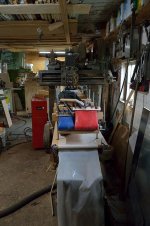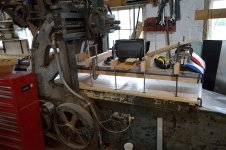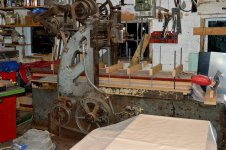maust
Aluminum
- Joined
- Apr 13, 2008
- Location
- Lilydale, Victoria/ Australia
Not sure if this is the right place to post this, but....
Save this planer from the scrapper, if you can. (It is in Texas.)
10ft bed, planes 8ft x 30in x 30in. Weighs 12000lbs!!! It is going to the scrap dealer real soon if no one saves it. Maybe you know someone who would want it if you don't. I just hate to see it scrapped.
Note: I have no personal interest in this machine other than hoping it doesn't go to scrap. I don't even live in the U.S.
If the link doesn't work, it is a Whitcomb metal planer on fb marketplace, in Texas
Log into Facebook
Save this planer from the scrapper, if you can. (It is in Texas.)
10ft bed, planes 8ft x 30in x 30in. Weighs 12000lbs!!! It is going to the scrap dealer real soon if no one saves it. Maybe you know someone who would want it if you don't. I just hate to see it scrapped.
Note: I have no personal interest in this machine other than hoping it doesn't go to scrap. I don't even live in the U.S.
If the link doesn't work, it is a Whitcomb metal planer on fb marketplace, in Texas
Log into Facebook







 . I'll keep an eye on it but hopefully someone grabs it. It's a little far and I don't really have it in the budget, but it would fit so nicely with my line-drive aspirations! Not to mention going well with my Whitcomb Blaisdall lathe. 8 feet of work area is a very useful size. It can't do everything, but enough to earn it's keep for it's size.
. I'll keep an eye on it but hopefully someone grabs it. It's a little far and I don't really have it in the budget, but it would fit so nicely with my line-drive aspirations! Not to mention going well with my Whitcomb Blaisdall lathe. 8 feet of work area is a very useful size. It can't do everything, but enough to earn it's keep for it's size. ). He has some investment in it already and wants to keep it out of the pile, but needs space and SOME kind of return on his investment (even if it's scrap yard value). He agree'd that breaking it up into multiple sections would make it easier to haul, and the table alone was about 3500 lbs.
). He has some investment in it already and wants to keep it out of the pile, but needs space and SOME kind of return on his investment (even if it's scrap yard value). He agree'd that breaking it up into multiple sections would make it easier to haul, and the table alone was about 3500 lbs.



 ), but had some time in the hotel and re-discovered David Richard's videos on Youtube. I think I had read about or seen one of the earlier ones before, but somehow missed that it was a series.
), but had some time in the hotel and re-discovered David Richard's videos on Youtube. I think I had read about or seen one of the earlier ones before, but somehow missed that it was a series. ....
....